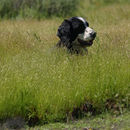Comprehensive Description
provided by North American Flora
Deschampsia danthonioides (Trin.) Munro; Benth. PI Hartw. 342. 1857.
Aira danthonioides Trin. M^m. Acad. St.-P^ersb. VI. 1: 57. 1830.
Deschampsia calycina Presl, Rel. Haenk. 1: 251. 1830. (Type from Monterey, California, Haenke.) Aira calycina Steud. Syn. PI. Gram. 220. 1854. (Based on Deschampsia calycina Presl.) Trisetum glabrum Buckl. Proc. Acad. Phila. 1862: 100. 1862. (Type said to be from "Texas,"
but probably from Columbia River.) Deschampsia gracilis Vasey, Bot. Gaz. 10: 224. 1885. (Type from San Diego, California, Orcutl
1073.) Deschampsia danthonioides var. gracilis Munz, Man. S. Calif. Bot. 45, 597. 1935. (Based on
D. gracilis Vasey.)
Annual; culms slender, erect, glabrous, 15-60 cm. tall; sheaths glabrous, striate; ligule pointed, 3-4 mm. long; blades few, short, scaberulous, flat or more or less involute, mostly less than 1 mm. wide; panicles open, 7-25 cm. long, the axis slender, scabrous, the capillary branches commonly in twos, stiffly ascending, distant, naked below, bearing a few shortpediceled spikelets toward the ends; gliunes narrow, 3-nerved, acuminate, glabrous except the slightly scabrous keel, much exceeding the florets, 4-8 mm. long; lemmas smooth and shining, turgid, somewhat indurate, 2-3 mm. long, the base of the florets and the rachilla pilose; awn from below the middle of the lemma, more or less geniculate, 4-6 mm. long, the lower part brown, twisted.
Type locality: Western North America.
Distribution: Open ground, Alaska to Montana and Baja California.
- bibliographic citation
- Albert Spear Hitchcock, Jason Richard Swallen, Agnes Chase. 1939. (POALES); POACEAE (pars). North American flora. vol 17(8). New York Botanical Garden, New York, NY
Physical Description
provided by USDA PLANTS text
Annuals, Terrestrial, not aquatic, Stems nodes swollen or brittle, Stems erect or ascending, Stems caespitose, tufted, or clustered, Stems terete, round in cross section, or polygonal, Stem internodes hollow, Stems with inflorescence less than 1 m tall, Stems, culms, or scapes exceeding basal leaves, Leaves mostly basal, below middle of stem, Leaves conspicuously 2-ranked, distichous, Leaves sheathing at base, Leaf sheath mostly open, or loose, Leaf sheath s mooth, glabrous, Leaf sheath and blade differentiated, Leaf blades linear, Leaf blades very narrow or filiform, less than 2 mm wide, Leaf blades 2-10 mm wide, Leaf blade margins folded, involute, or conduplicate, Leaf blades mostly glabrous, Leaf blades scabrous, roughened, or wrinkled, Ligule present, Ligule an unfringed eciliate membrane, Inflorescence terminal, Inflorescence an open panicle, openly paniculate, branches spreading, Inflorescence solitary, with 1 spike, fascicle, glomerule, head, or cluster per stem or culm, Inflorescence branches more than 10 to numerous, Lower panicle branches whorled, Flowers bisexual, Spikelets pedicellate, Spikelets laterally compressed, Spikelet less than 3 mm wide, Spikelets with 2 florets, Spikelets solitary at rachis nodes, Spikelets all alike and fertille, Spikelets bisexual, Spikelets disarticulating above the glumes, glumes persistent, Spikelets disarticulating beneath or between the florets, Rachilla or pedicel hairy, Glumes pre sent, empty bracts, Glumes 2 clearly present, Glumes equal or subequal, Glumes distinctly unequal, Glumes equal to or longer than adjacent lemma, Glume equal to or longer than spikelet, Glumes 1 nerved, Glumes 3 nerved, Lemma similar in texture to glumes, Lemma coriaceous, firmer or thicker in texture than the glumes, Lemma 5-7 nerved, Lemma glabrous, Lemma body or surface hairy, Lemma apex dentate, 3-5 fid, Lemma distinctly awned, more than 2-3 mm, Lemma with 1 awn, Lemma awn less than 1 cm long, Lemma awn subapical or dorsal, Lemma awn twisted, spirally coiled at base, like a corkscrew, Lemma awn once geniculate, bent once, Lemma margins thin, lying flat, Lemma straight, Callus or base of lemma evidently hairy, Callus hairs equal to lemma, Palea present, well developed, Palea membranous, hyaline, Palea longer than lemma, Palea 2 nerved or 2 keeled, Stamens 3, Styles 2-fid, deeply 2-branched, Stigmas 2, Fruit - caryopsis, Caryopsis ellipsoid, longitudinally grooved, hilum l ong-linear.

